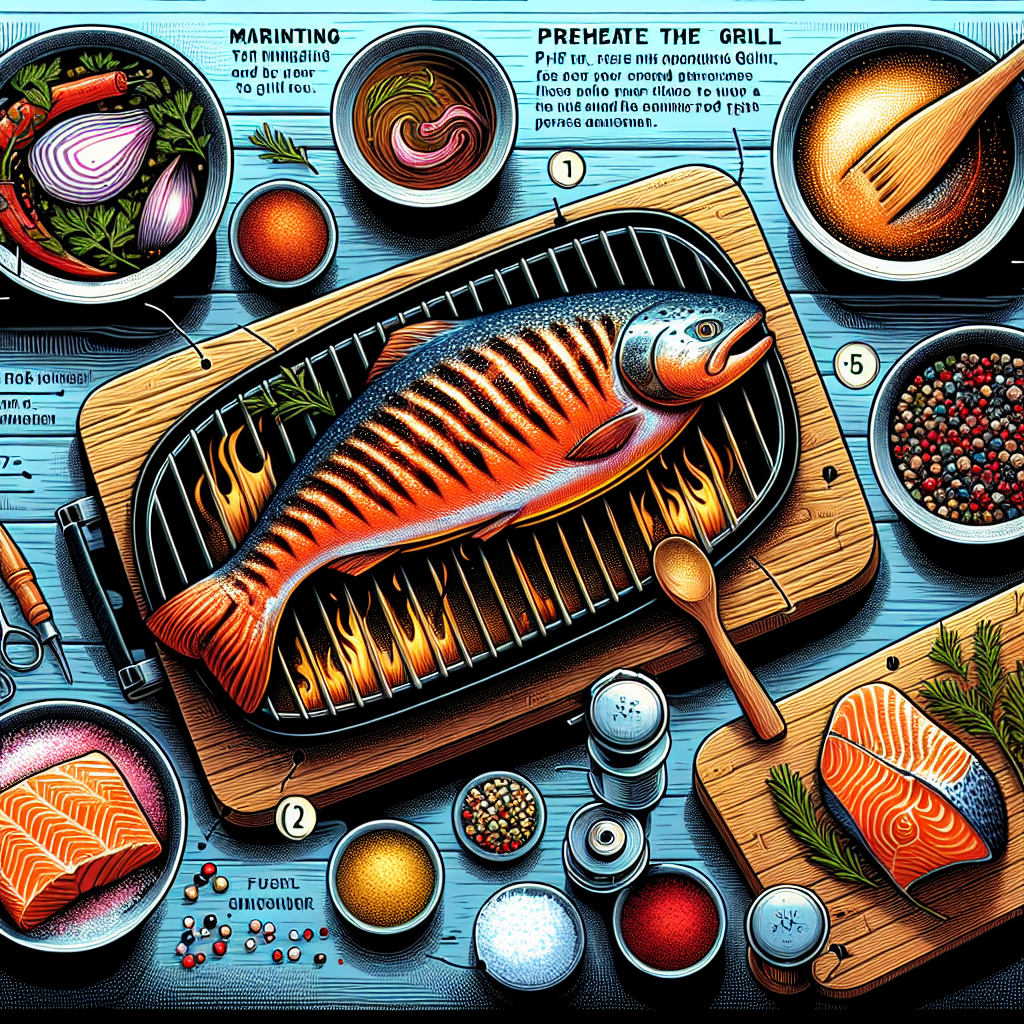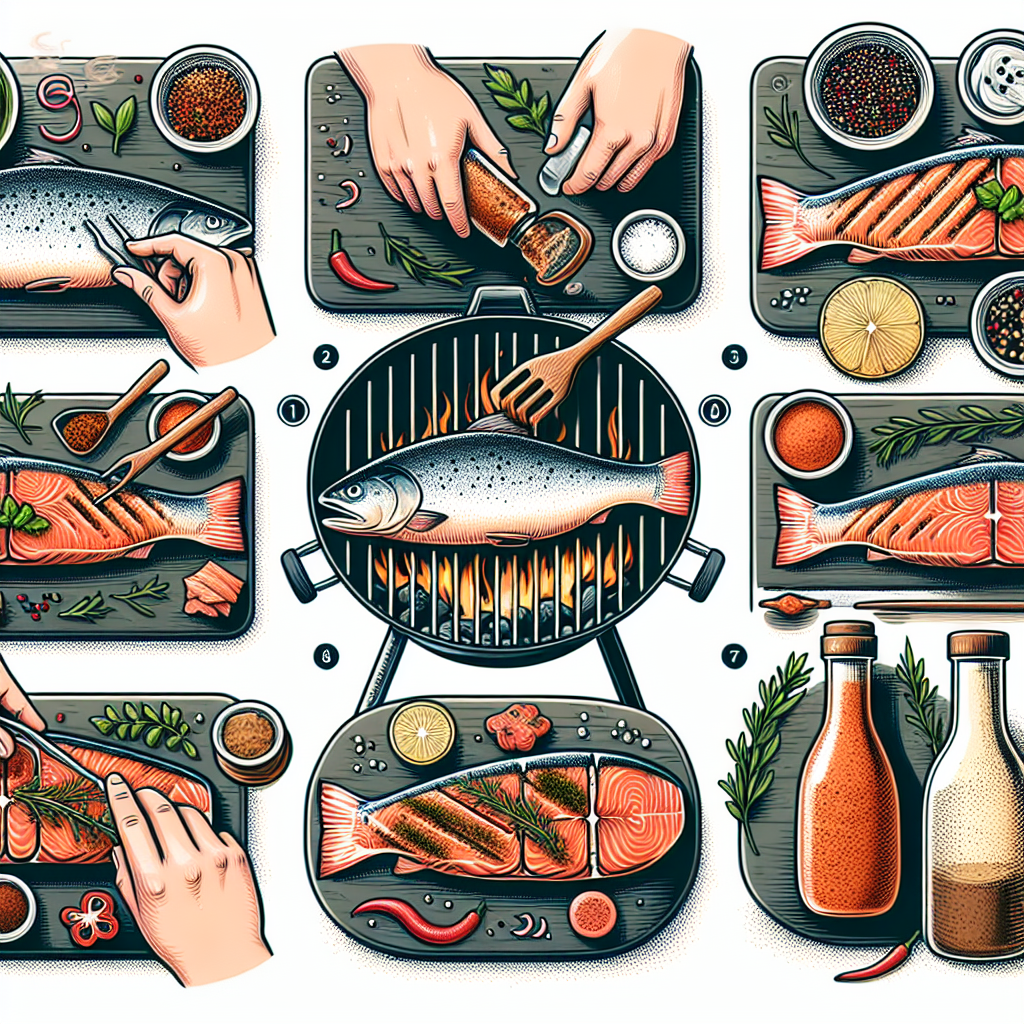If you’re looking to savor a deliciously flavorful and perfectly cooked piece of salmon, then look no further than the grill! Cooking salmon on the grill not only imparts a smoky and charred taste that complements the fish beautifully, but it also ensures a moist and tender texture. In this article, you’ll discover simple yet effective techniques on how to achieve grilled salmon perfection. From preparing the marinade to mastering the ideal cooking time, you’ll soon be confidently grilling up a feast of delectable salmon that will have your taste buds singing with delight. So grab your apron, fire up the grill, and get ready to tantalize your senses with the mouthwatering magic of grilled salmon!
Selecting the Salmon
When it comes to grilling salmon, selecting the right salmon is crucial for a delicious and satisfying meal. Whether you choose fresh or frozen salmon will largely depend on your personal preference and the availability of fresh salmon in your area.
Fresh vs Frozen
Fresh salmon is often the top choice for many grill enthusiasts as it tends to have a vibrant color, firm texture, and a delicate flavor. However, if fresh salmon is not readily available, frozen salmon can be an excellent alternative. Frozen salmon is typically flash-frozen shortly after being caught, which helps preserve its quality and taste.
Choosing the Right Cut
When it comes to grilling salmon, there are various cuts to choose from, each with its own unique characteristics. Two popular cuts for grilling are fillets and steaks. Fillets are boneless and offer a delicate texture, while steaks are cut crosswise and contain the bone, which imparts a slightly different flavor. Ultimately, the choice between fillets and steaks comes down to personal preference.
Skin-On or Skin-Off
Another decision to make when selecting salmon for grilling is whether to choose skin-on or skin-off salmon. The skin can add extra flavor and help protect the fish from sticking to the grill. If you prefer crispy skin, grilling skin-on salmon is a great choice. On the other hand, if you prefer to remove the skin before eating, opt for skin-off salmon.
Preparing the Salmon
Before you can start grilling your salmon, there are a few important steps to follow in order to prepare the fish properly.
Thawing the Salmon
If you’re using frozen salmon, it’s essential to thaw it before grilling. The best method for thawing salmon is to place it in the refrigerator overnight. This gradual thawing process helps maintain the salmon’s texture and prevents the fish from becoming mushy.
Seasoning Options
Seasoning is a crucial step in enhancing the flavor of the salmon. You can keep it simple by using basic seasonings like salt, pepper, and lemon juice, or get creative with a variety of herbs and spices. Some popular seasoning options for grilled salmon include dill, garlic, paprika, and soy sauce. Experiment with different combinations to find your favorite flavor profile.
Marinating the Salmon
Marinating the salmon is another way to infuse it with additional flavors and keep it moist during the grilling process. A simple marinade can be made by combining olive oil, lemon juice, minced garlic, and your choice of herbs and spices. Allow the salmon to marinate for at least 30 minutes, or up to 4 hours, in the refrigerator for optimal flavor infusion.

Prepping the Grill
Before you fire up the grill, it’s important to prepare it properly to ensure a successful grilling experience.
Cleaning the Grill
Start by thoroughly cleaning the grill grates to remove any leftover residue from previous meals. Use a brush or grill scraper to scrub away any stuck-on food particles. This not only helps prevent sticking but also promotes even heat distribution.
Preheating the Grill
Preheating the grill is a crucial step to ensure that the salmon cooks evenly and prevents sticking. Turn on the grill and let it heat up for about 10-15 minutes, or until the temperature reaches around 400°F (200°C). This step helps create those beautiful grill marks and seals in the moisture of the salmon.
Choosing the Right Heat Level
When it comes to grilling salmon, it’s important to find the right balance of heat. Too much heat can cause the salmon to cook too quickly, resulting in dry and overcooked fish. On the other hand, insufficient heat can lead to undercooked salmon. Aim for medium heat, which is around 350°F (175°C) to 400°F (200°C), to achieve a perfectly grilled salmon.
Grilling Techniques
Now that you’ve prepared the salmon and prepped your grill, it’s time to explore different grilling techniques to achieve that desired texture and flavor.
Direct Grilling
Direct grilling involves placing the salmon directly over the heat source. This technique is ideal for smaller cuts or thin fillets as it quickly cooks the salmon. Grill each side for approximately 3-4 minutes, or until the salmon is opaque and flaky. Be sure to monitor the cooking process closely to prevent overcooking.
Indirect Grilling
Indirect grilling is a great option for larger cuts of salmon or when you prefer a slower cooking method. To achieve indirect grilling, place the salmon on the cooler side of the grill or turn off one burner if using a gas grill. This allows the salmon to cook more gently and evenly. Cook for around 12-15 minutes, depending on the thickness of the salmon, flipping once halfway through.
Cedar Plank Grilling
Cedar plank grilling is a popular method that imparts a smoky and unique flavor to the salmon. Soak a cedar plank in water for at least 30 minutes to prevent it from catching fire. Place the seasoned salmon on the soaked cedar plank and grill indirectly, keeping the lid closed. This method not only adds flavor but also prevents the salmon from sticking to the grill grates.

Grilling Tips and Tricks
To ensure a successful grilling experience, here are some helpful tips and tricks to keep in mind when cooking salmon on the grill.
Oil the Grill Grates
Before placing the salmon on the grill, lightly oil the grill grates. This helps prevent sticking and ensures easy removal of the salmon once it’s cooked. Use a high smoke point oil like canola or vegetable oil and a folded piece of paper towel to apply a thin layer of oil to the grates.
Grill with the Skin Side Down First
When grilling skin-on salmon, start by placing it on the grill with the skin side down. This helps protect the flesh from direct heat and helps the fish retain its moisture. The skin will also crisp up nicely during the cooking process, adding an extra layer of texture to your grilled salmon.
Avoid Overcooking
Overcooking salmon can result in a dry and less flavorful fish. Keep a close eye on the grilling process and use a meat thermometer to check for doneness. The salmon is cooked when it reaches an internal temperature of 145°F (63°C). Remember that the salmon will continue to cook for a few minutes after it’s taken off the grill, so it’s better to slightly undercook it than to overcook it.
Monitoring the Cooking Process
To ensure that your grilled salmon is perfectly cooked, it’s helpful to monitor the cooking process using both visual cues and a meat thermometer.
Using a Meat Thermometer
A meat thermometer is a handy tool for determining the doneness of your grilled salmon. Insert the thermometer probe into the thickest part of the salmon, making sure it doesn’t touch the bone if using a steak. When the salmon reaches an internal temperature of 145°F (63°C), it’s ready to be taken off the grill.
Checking for Doneness
Aside from using a meat thermometer, you can also visually check for doneness. Grilled salmon should be opaque throughout and flake easily with a fork. The flesh should be slightly firm but still moist. If the salmon appears translucent or still has a raw-looking center, it needs more time on the grill.
Serving and Garnishing
Once your salmon is perfectly grilled, it’s time to bring it to the table and make it visually appealing as well.
Presentation Tips
Presentation plays a significant role in elevating the overall dining experience. Serve the grilled salmon on a platter or individual plates, placing any side dishes alongside it. Consider using garnishes, such as fresh herbs or lemon slices, to add a pop of color and freshness to the dish. Remember, a beautifully presented meal is an invitation to enjoy the flavors and textures of your grilled salmon.
Garnishing Options
Garnishing options for grilled salmon are endless and can be tailored to your taste preferences. Sprinkle some freshly chopped herbs, like dill or parsley, over the salmon to add a burst of freshness. Squeeze a lemon wedge over the salmon or serve it with a side of tartar sauce, aioli, or a flavorful salsa to enhance the taste. Don’t be afraid to get creative and experiment with different garnishes to find what complements your grilled salmon best.
Accompaniments
Pairing your grilled salmon with the right accompaniments can take your meal to another level. Consider serving it with a side of grilled vegetables, such as asparagus or zucchini, or a refreshing green salad dressed with a light vinaigrette. Rice, quinoa, or roasted potatoes make excellent starch options to complement the salmon. Experiment with different combinations to create a well-rounded and satisfying meal.
Grilling salmon on the grill can be a rewarding experience, especially when you follow these comprehensive guidelines. From selecting the salmon to determining its doneness and garnishing it beautifully, each step contributes to a delicious and memorable meal. So fire up the grill, get your salmon ready, and prepare to impress your guests or yourself with perfectly grilled salmon every time.
